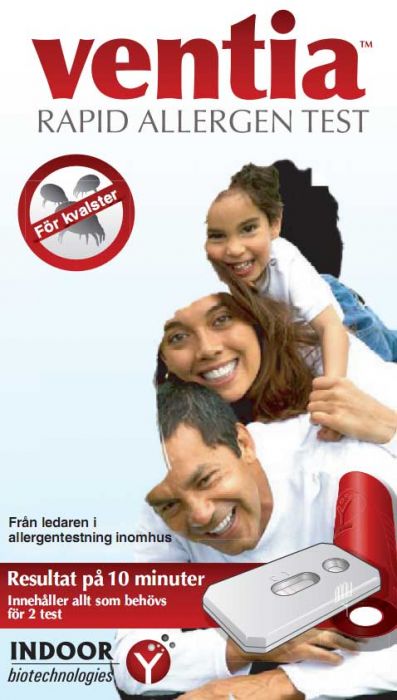Ventia Kvalsterallergentest
Frakt: 34-49 kr. Skickas normalt inom 1-3 dagar på vardagar.
Betalning:
Visa/Mastercard och Swish: 0 kr
Ring för postförskott: 100 kr (Postnord/DHL avgift)
Har jag kvalster i sängen?
Med Ventia ™ kvalsterallergentest kan sjukvårdspersonal enkelt undersöka vilka kvalsterallergennivåer som finns i sängar, mattor och möbler. Det tar ca 10 minuter att utföra och det enda man behöver är en dammsugare av valfritt märke. Ventia-testet innehåller två kompletta testomgångar.Utförliga instruktioner om hur testet skall utföras medföljer.
Ventia kvalstertest är ett enkelt screeningtest som är specifikt för två av de vanligast förekommande kvalsterarter som ger kvalsterallergibesvär.
Testet är ett semi-kvantitativt immunologiskt snabbtest för huvudallergener Der p och Der f. Testet har en känslighet på ca 10ng allergen per ml. Ventia kvalsterallergentest visar en god överensstämmelse med ELISA-test.
Instruktion
- Ladda ner instruktion för Ventia (630kB)
- Se film hur man använder Ventia. På engelska.
Referenser
Rapid Test for Mite Allergen Detection in the Home: Correlation with ELISA.
A. Tsay* BS, L. Williams PhD, J. Chandler PhD, M.D. Chapman PhD.
Cardiff, U.K., and Charlottesville, VA.
(J Allergy Clin Immunol 1999; 103:S235)
Abstract: Allergen avoidance is the first line of treatment for the management of patients with allergic rhinitis and asthma. Exposure to indoor allergensis usually assessed by ELISA analysis of dust samples, however, ELISA is not suitable for home use.
We compared Der p 1 and Der p 2 ELISA on dust samples collected in the UK, Brazil and New Zealand. The Der p 2 ELISA results were compared with a semi-quantitative lateral flow rapid test for mite Group 2 allergen.
The rapid test uses gold labelled antibodies, develops within 10 minutes and has a sensitivity of ~10ng/ml Group 2 allergen.
The use of the rapid test with a dust sampling device (MITEST) was also evaluated. Der p 1 and Der p 2 ELISA results in dust samples were highly correlated (n=168, r=0.70, p<0.001).
Semi-quantitative evaluation of Der p 2 ELISA with the rapid test showed a good correlation, with 108/130 samples (83%) showing good to excellent results when compared on a + to +++ visual scale.
Dust samples (n=37) were collected and extracted from 0.25m2 bedding, carpet, or soft furnishings using the MITEST dust collector and assayed for mite Group 2 allergen by ELISA and rapid test. Mean dust weight collected by MITEST was 140mg (bed); 747mg (carpet) and 87mg (furn). Group 2 allergen levels (ELISA) ranged from 10-140ng/ml.
Twenty two samples contained no detectable Group 2 by ELISA and were negative on the rapid test. There were two false negative samples on the rapid test, but otherwise the results correlated with ELISA.
The results suggest that the rapid test for Group2 is suitable for assessing mite allergen exposure in the home and will enable patients to monitor current exposure and the effects of allergen of avoidance procedures.
